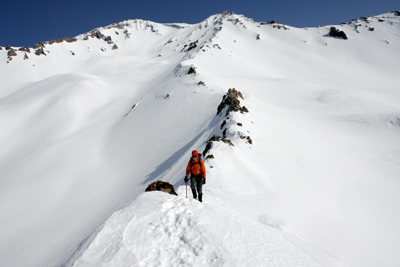|
The dark side of Mount Shasta
 |
Zach Urness/Daily Courier
Green Butte route on California's Mount Shasta. |
On March 27, 2010, Thomas Bennett was trapped near the 14,130-foot summit of Mount Shasta during a snowstorm and eventually died due to severe altitude sickness. I was climbing Mount Shasta the same day using a different route, and also suffered from altitude sickness. This is the story I wrote for the Grants Pass Daily Courier when the news broke.o o o oBy Zach Urness of the Daily CourierEach step sent a wave of nausea through my stomach. My head felt split open by an axe, and each movement seemed weighed down by an invisible jacket of brick. It was 8 a.m. Saturday, and I was climbing my way toward 13,000 feet on California’s Mount Shasta, the second-tallest mountain in the Cascade Range.The summit felt somehow close, as though just beyond the orange sunlight spreading across the snowy valleys. But the grip of altitude sickness drained my energy and caused me to vomit breakfast onto the snow.“You’ve got to stop,” said my climbing partner, Brian Dickinson, an expert mountaineer and 1992 Rogue River High School graduate. “The most dangerous time is when you’re sick and exhausted. That’s when mistakes happen. It’s not worth it to keep going.”I was lucky.Dickinson pounded home how serious altitude sickness can become. We both knew a storm might hit the mountain later that day and there wasn’t time to dawdle. As much as it stung my ego — and it did, because I’ve climbed 14,000-foot mountains before — I turned around and headed down without reaching the summit.It may be the best decision I’ve ever made.On Monday, stories began to emerge about two climbers from the San Francisco Bay Area who ascended Mount Shasta the same Saturday as myself, although by a different route.Thomas Bennett and Mark Thomas, both 26, reached the 14,162-foot summit sometime late Saturday. They were trapped by the violent winds and had to spend the night at 14,050 feet in blizzard conditions.Bennett became disoriented and eventually immobilized by severe altitude sickness, reports indicate.By Monday, Thomas was forced to leave his unconscious friend in a snow cave on the mountain and climb down to seek help.Powerful winds, freezing temperatures and poor visibility prevented rangers from conducting an immediate search. Officials now fear Bennett is dead.When something this awful happens, it’s hard to know exactly what to think.Some reports indicate the pair didn’t check in with rangers before their climb. Mark Thomas had a seasonal pass, so he wasn’t required to fill out a permit to go above 10,000 feet, as most people do. Still, checking in would have made it easier to pinpoint the climbers’ route and provided them with an updated weather report. These both are important points.Climbing Mount Shasta is a huge undertaking, and even the smallest oversights can have serious consequences. You dig a base camp into the snow high on the mountain, sleep in the freezing cold, and typically begin climbing in the moonlit darkness of 2 to 3 a.m. Depending on the route, there are any number of physical and technical obstacles to face as you ascend thousands of feet, one step at a time.Once the summit feels within reach, there’s an impulse to flout signs of danger, to push through the pain and bad weather.When you’re 26 years old, as I am, you feel invincible. Even if you understand the danger, there’s an inherent belief that bad things only happen in movies or books.It’s also easy to overlook Mount Shasta. While the easiest routes were closed Friday due to avalanche danger, Shasta generally is viewed by mountaineering experts as a “nontechnical” mountain — an easy climb. That hubris can lead people to forget it’s still a 14,000-foot mountain of ice, snow and erratic weather.It’s difficult to speculate exactly what happened to Bennett and Thomas. Reports indicate both had previously been to Shasta’s summit and were experienced climbers. They apparently were prepared with the exception of checking the latest weather forecast.I didn't meet them on the mountain that day. My partner, Dickinson, who climbed to the summit, never saw them either.More than anything, I hope that Bennett is found safely. I hope his parents can hug him and his mother can yell at him for putting himself in such a precarious situation.What I do know is this: What happened to Bennett could happen to any climber. It’s not easy to turn around, even if you’re feeling altitude sickness or the weather appears threatening.Fortunately I had Dickinson by my side for a reality check.I only wish Bennett had been so lucky.
| |
|





